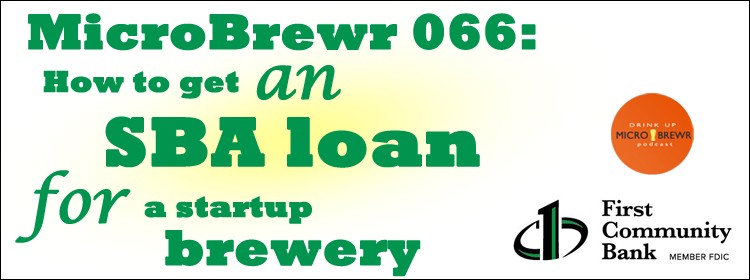MicroBrewr 068: An SBA loan can help open or grow your brewery
Podcast: Play in new window | Download | Embed
Subscribe: RSS
Two years ago, Adam Charnack and his partners got a $254,000 SBA-backed loan to start Hi-Wire Brewing in Asheville, North Carolina. Today, they’re expanding to a second brewery with another SBA loan.
“The SBA involvement in craft beer,” says Adam, “has been a part of the success of craft breweries being able to open and grow.”
“The way that banks are willing to look at breweries is totally different under and SBA lens. We’re all just young guys that wanted to start a brewery. So we’re not rolling in [money] or have some big financing. Without SBA involved it definitely would make getting financing a whole lot more difficult.”
Adam advises to focus on your business plan. “If you show up with a notebook paper, or a page-and-a-half typed, with a bunch of typos on it, that’s not going to cut it.”
The financials are the most important things that banks look for when you apply for funding:
- Financial projections
- How much it’s going to cost to make things
- When you’re going to get paid
- What the prices are
- Sources and uses of funds
- Projected and net operating income (12 months, and next few years)
- Cash flow
“A lot of that is a shot in that dark,” admits Adam, “but at least you’re making intelligent assumptions.”
With so many breweries in and around Asheville, there is an abundance of qualified workers. Even still, employee retention is important.
“We’ve never had anybody leave our company that started with us in the last 2 years in our brewery operations,” says Adam.
His tips on how to keep quality workers:
- Throw parties throughout the year.
- Organize fun company outings.
- Have a lot of fun.
- Respect people.
- Provide opportunity.
“If you treat people right and you respect people,” says Adam, “we’ve had no problem retaining talent here.”
Other tips:
- Bring on a partner with an understanding of, or background in, finance.
- Assets or an alternative means to payback a loan helps to secure funding.
Advice for someone who wants to do what he has done:
Brewery specs:
Kettle size: 30 BBL + 30 BBL (two breweries).
Size and quantity of fermentation tanks: 90-BBL and 30-BBL.
Size and quantity of bright tanks: 90-BBL and 30-BBL.
Annual brewing capacity/last year’s production: In September 2015, capacity will be approx.. 17,000 BBL/year. By year’s end, on pace of 10,000 BBL/year.
Square footage: 27,000 sq. ft. and 4,000 sq. ft.
Years in operation: 2 years (opened July 2013).
“I would definitely advise having a business partner.” [Tweet This]
Listener question:
From Daniel: What’s your biggest regret?
Book recommendation:
- Beyond the Pale: The Story of Sierra Nevada Brewing Co. by Ken Grossman.
- Brewing Up a Business: Adventures in Beer from the Founder of Dogfish Head Craft Brewery by Sam Calagione.
- Beer School: Bottling Success at the Brooklyn Brewery by Steve Hindy and Tom Potter.
Check out the entire list of recommended books, click here.
An upcoming beer style:
Lager
Other resources:
- Turns Out, Uncle Sam Is a Beer Lover, Darren Dahl, Inc., June 2013.
- MicroBrewr 066: How to get an SBA loan for a startup brewery, MicroBrewr, May 26, 2015.
- SCORE, free small business advice.
- South Yeast, the nations first bank for regionally unique microorganisms for the fermented food and beverage industries.
- What About Bob? movie in iTunes.
- Beer Bloggers & Writers Conference.
You can reach Adam Charnack and Hi-Wire Brewing at:
Sponsors:
Support MicroBrewr
Help keep MicroBrewr on the air. CLICK HERE for ways you can help.





